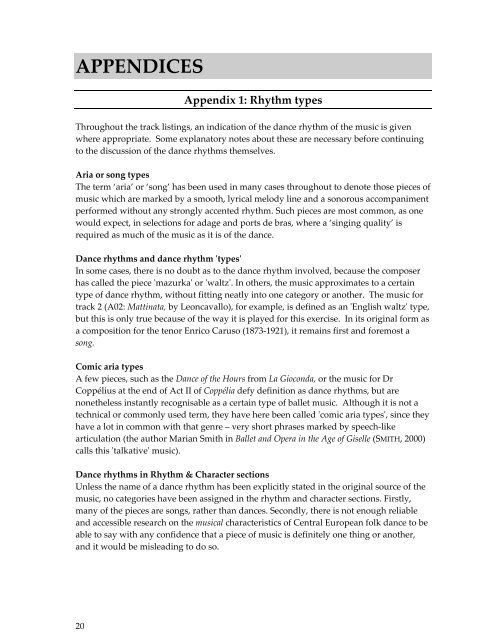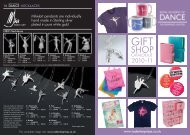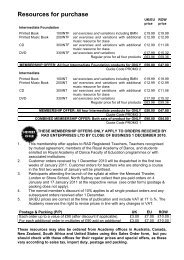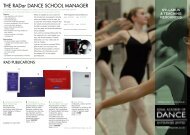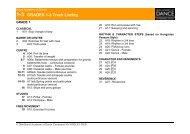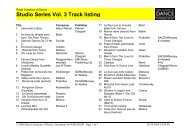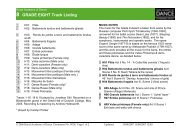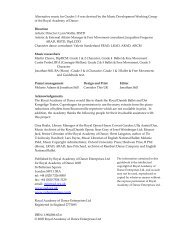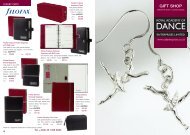to download the guide book in - Royal Academy of Dance Enterprises
to download the guide book in - Royal Academy of Dance Enterprises
to download the guide book in - Royal Academy of Dance Enterprises
You also want an ePaper? Increase the reach of your titles
YUMPU automatically turns print PDFs into web optimized ePapers that Google loves.
APPENDICES<br />
20<br />
Appendix 1: Rhythm types<br />
Throughout <strong>the</strong> track list<strong>in</strong>gs, an <strong>in</strong>dication <strong>of</strong> <strong>the</strong> dance rhythm <strong>of</strong> <strong>the</strong> music is given<br />
where appropriate. Some explana<strong>to</strong>ry notes about <strong>the</strong>se are necessary before cont<strong>in</strong>u<strong>in</strong>g<br />
<strong>to</strong> <strong>the</strong> discussion <strong>of</strong> <strong>the</strong> dance rhythms <strong>the</strong>mselves.<br />
Aria or song types<br />
The term ‘aria’ or ‘song’ has been used <strong>in</strong> many cases throughout <strong>to</strong> denote those pieces <strong>of</strong><br />
music which are marked by a smooth, lyrical melody l<strong>in</strong>e and a sonorous accompaniment<br />
performed without any strongly accented rhythm. Such pieces are most common, as one<br />
would expect, <strong>in</strong> selections for adage and ports de bras, where a ‘s<strong>in</strong>g<strong>in</strong>g quality’ is<br />
required as much <strong>of</strong> <strong>the</strong> music as it is <strong>of</strong> <strong>the</strong> dance.<br />
<strong>Dance</strong> rhythms and dance rhythm ʹtypesʹ<br />
In some cases, <strong>the</strong>re is no doubt as <strong>to</strong> <strong>the</strong> dance rhythm <strong>in</strong>volved, because <strong>the</strong> composer<br />
has called <strong>the</strong> piece ʹmazurkaʹ or ʹwaltzʹ. In o<strong>the</strong>rs, <strong>the</strong> music approximates <strong>to</strong> a certa<strong>in</strong><br />
type <strong>of</strong> dance rhythm, without fitt<strong>in</strong>g neatly <strong>in</strong><strong>to</strong> one category or ano<strong>the</strong>r. The music for<br />
track 2 (A02: Matt<strong>in</strong>ata, by Leoncavallo), for example, is def<strong>in</strong>ed as an ʹEnglish waltzʹ type,<br />
but this is only true because <strong>of</strong> <strong>the</strong> way it is played for this exercise. In its orig<strong>in</strong>al form as<br />
a composition for <strong>the</strong> tenor Enrico Caruso (1873‐1921), it rema<strong>in</strong>s first and foremost a<br />
song.<br />
Comic aria types<br />
A few pieces, such as <strong>the</strong> <strong>Dance</strong> <strong>of</strong> <strong>the</strong> Hours from La Gioconda, or <strong>the</strong> music for Dr<br />
Coppélius at <strong>the</strong> end <strong>of</strong> Act II <strong>of</strong> Coppélia defy def<strong>in</strong>ition as dance rhythms, but are<br />
none<strong>the</strong>less <strong>in</strong>stantly recognisable as a certa<strong>in</strong> type <strong>of</strong> ballet music. Although it is not a<br />
technical or commonly used term, <strong>the</strong>y have here been called ʹcomic aria typesʹ, s<strong>in</strong>ce <strong>the</strong>y<br />
have a lot <strong>in</strong> common with that genre – very short phrases marked by speech‐like<br />
articulation (<strong>the</strong> author Marian Smith <strong>in</strong> Ballet and Opera <strong>in</strong> <strong>the</strong> Age <strong>of</strong> Giselle (SMITH, 2000)<br />
calls this ʹtalkativeʹ music).<br />
<strong>Dance</strong> rhythms <strong>in</strong> Rhythm & Character sections<br />
Unless <strong>the</strong> name <strong>of</strong> a dance rhythm has been explicitly stated <strong>in</strong> <strong>the</strong> orig<strong>in</strong>al source <strong>of</strong> <strong>the</strong><br />
music, no categories have been assigned <strong>in</strong> <strong>the</strong> rhythm and character sections. Firstly,<br />
many <strong>of</strong> <strong>the</strong> pieces are songs, ra<strong>the</strong>r than dances. Secondly, <strong>the</strong>re is not enough reliable<br />
and accessible research on <strong>the</strong> musical characteristics <strong>of</strong> Central European folk dance <strong>to</strong> be<br />
able <strong>to</strong> say with any confidence that a piece <strong>of</strong> music is def<strong>in</strong>itely one th<strong>in</strong>g or ano<strong>the</strong>r,<br />
and it would be mislead<strong>in</strong>g <strong>to</strong> do so.


